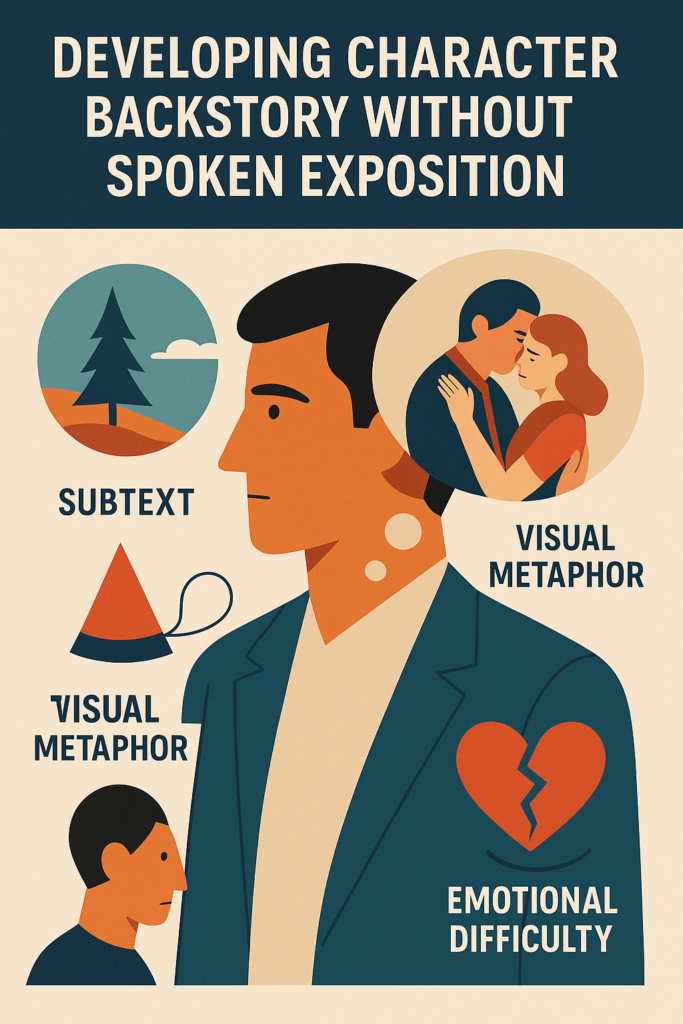How to Develop Character Backstory (Without Spoken Exposition)

One of the cardinal sins of novice screenwriting is the “info dump”—that moment when a character halts the story to say, “When I was a child, my father left me, and I’ve had trust issues ever since.”
This is precisely when the audience yawns and reflex-checks TikTok.
Let’s face it: exposition is the least cinematic way to reveal backstory.
Yet still, understanding a character’s past is essential to understanding their present. Character backstory gives us empathy, tension, and motivation—to deliver it successfully, do so with restraint and in the language of cinema: action, image, and subtext.
The best screenwriters weave backstory into the tapestry of a scene, often without a single word of explanation.
In this post, we’ll explore five powerful methods for revealing backstory without dumping dialogue:
- Subtext
- Life Situation
- Visual Metaphor
- Emotional Difficulty
- Symbolic Behavior
Let’s look at some examples of each of these from classic and contemporary screen works, including Twin Peaks, Manchester by the Sea, Breaking Bad, The Social Network, and Moonlight.
1. Subtext: Say One Thing, Mean Another
Subtext is the unspoken truth behind words; it allows writers to communicate a character’s inner life without having to spell it out.
🎬 Example: Twin Peaks – Cooper and Caroline
In Twin Peaks, FBI Agent Dale Cooper’s backstory—particularly his tragic connection to Windom Earle’s wife, Caroline—is barely spoken of.
What we gather comes through allusion, hesitation, and mood. Cooper avoids talking about Caroline directly, but we see how her death has shaped his caution in romantic entanglements, particularly as things develop with Annie toward the end of Season 2.
Rather than explaining his guilt or trauma, Cooper projects an emotionally measured, overly moral persona. This, paired with cryptic allusions to his past and his meticulous, obsessive habits, fills in the gaps. The character lives the emotional wound; we don’t need a specific diagnosis.
Tip for Writers: Write scenes where your character avoids the topic that matters most. What they don’t say is more revealing than what they do.
2. Life Situation: Let the Past Be Present
Sometimes a character’s backstory is best revealed by placing them in a life situation that reflects or contradicts their past. This avoids exposition entirely. Instead, the world becomes the mirror of the character’s history.
🎬 Example: Manchester by the Sea – Lee’s Daily Existence
Lee Chandler, played by Casey Affleck, is a janitor in Manchester by the Sea. He lives in quiet isolation, avoids others, and barely speaks. For the first third of the film, we’re given no direct exposition about why Lee is this way.
Then comes the reveal: Lee accidentally caused the fire that killed his children. But even after we learn this, the film does not belabor it with explanation. Lee’s backstory lives in his daily suffering, in the way he walks, interacts, and isolates himself. His life situation is the exposition.
Tip for Writers: Construct your character’s job, routine, and relationships so they naturally reflect what’s happened. Let us feel this in every choice the character makes.
3. Visual Metaphor: Show, Symbolize, Suggest
Sophisticated backstories often emerge through symbolism—a photograph, a scar, a worn-out jacket, a childhood home. When used well, these elements evoke the past with poetic precision.
🎬 Example: Moonlight – The Bathtub, the Ocean
In Moonlight, we follow Chiron through three life stages. His backstory involves poverty, bullying, drug addiction, and repressed sexuality, yet none of this is explained outright. Instead, director Barry Jenkins uses visual metaphor.
The bathtub, where his mother spirals into addiction, and the ocean, where Chiron shares a formative moment with Kevin, are recurring symbols. These aren’t just places—they’re emotional landscapes tied to his past. They convey intimacy, fear, and change.
Tip for Writers: Give your character a recurring visual motif. Don’t explain it—just let it return. Over time, the audience will naturally attach meaning to it.
4. Emotional Difficulty: What Your Character Can’t Handle
Emotional avoidance presents a powerful way to reveal backstory. If a character consistently resists a particular emotion or situation, such avoidance tells a story.
🎬 Example: Breaking Bad – Walt’s Pride
Walter White rarely talks about his past—specifically, why a man as brilliant as him ended up teaching high school chemistry. Gray Matter, the billion-dollar company he helped found, is only revealed through Walt’s defensiveness.
Every time the company is brought up, Walt becomes aggressive, sarcastic, or emotionally withdrawn.
This behavior reveals that Walt’s primary wound is pride. He’s driven by humiliation, resentment, and a need to reclaim lost status. The emotional energy around his backstory reveals more than words ever could.
This tells us a lot about how Walt (and Heisenberg) develops throughout the course of the show.
Tip for Writers: Show a character struggling to feel something. Rage, shame, grief—if they avoid these emotions, we’ll ask why.
5. Symbolic Behavior: Repetition with a Reason
When a character repeats an unusual behavior—checking a lock five times, folding clothes with military precision, refusing to eat a certain food—it often points to a deeper cause rooted in backstory. The audience picks up on it intuitively, without explanation.
🎬 Example: The Social Network – Zuckerberg’s Wardrobe
In The Social Network, Mark Zuckerberg is portrayed as emotionally incompetent, hyper-focused, and status-obsessed (of course this is the character; surely none of those things are true of the actual person…).
Though the film never gives a definitive account of Zuck’s backstory, it hints at his insecurities and class resentment.
His hoodie-and-jeans uniform, his obsession with Harvard clubs and elite networks, and his cold, transactional manner all suggest a man who feels excluded—a man whose backstory likely involves being underestimated, unloved, and out-of-place.
Tip for Writers: Give your character a behavior that doesn’t quite fit—let the audience wonder why. If there is a moment where the reason for this is revealed–or even just implied–this will hit harder than some on-the-nose explanation of the same.
Even More Tools and Techniques
If you’ve mastered the above five, here are a few more subtle tools to deepen character backstory:
A. Haunted Relationships
Create a character who avoids, seeks, or sabotages a particular relationship type (father figures, romantic partners, authority figures). Such a pattern speaks volumes about the character’s past.
B. Music and Objects
A song, an object, or a place can evoke memory. Let a character react emotionally to something seemingly innocuous–this means there’s a story we don’t know yet.
C. Avoidance of a Place or Role
If your character refuses to return to her hometown, won’t take a leadership role, or avoids a specific job or setting, this almost certainly hints at unresolved past trauma.
Avoid the Exposition Trap
OK, OK–not all exposition is bad. Sometimes it’s even necessary!
However, spoken exposition needs to be earned, and if well-placed it almost certainly won’t come within the first ten minutes–or even at all in Act One.
When exposition is revealed through an emotional exchange–particularly through action or image, the audience leans in. Think Mr. Miyagi getting weepy drunk in front of Daniel-san halfway through the film.
Shitty exposition usually comes like this:
- On-the-nose monologues
- Flashbacks with voiceover
- Dialogue like “When I was orphaned at age 12…”
Dialogue, at most, is the tip of the iceberg. We can feel and intuit a lot that’s not literally said.
Practice Good Exposition
Exercise – develop character backstory without direct exposition:
- Write a 2-sentence summary of your character’s key past trauma or wound.
- Now write three scenes where they express this past indirectly:
- In what she won’t say
- In how she react to a person or place
- In an unusual action or symbolic choice
- In what she won’t say
Each of these scenes must pique the audience’s curiosity–it needs to raise a question. If the audience wonders why she’s always doing that weird thing, the strategy is working.
What’s Unsaid
As a screenwriter, your job is not to explain a character; it’s to let the audience discover a character.
The most memorable characters in film and TV—Don Draper, Chiron, Lisbeth Salander, Tony Soprano, Marge Gunderson—are not powerful because we know their history, but because we feel its weight in everything they do.
It makes the character’s particular behavior traits–often bad in Don Draper or Tony Soprano’s case, nearly always good in the case of Marge Gunderson–feel natural. We don’t dislike Don when he cheats yet again, and we don’t find Marge cloying when she’s unfailingly kind yet again.
Backstory haunts the present; remember, ghosts don’t often speak. They are seen in peripheral vision, appear in dreams, or end up jumping out like a jack in the box if a raw nerve is struck.
So next time you’re tempted to write, “Let me tell you what happened,” stop. You’ll do everyone a favor.
There is a better way to write this.

